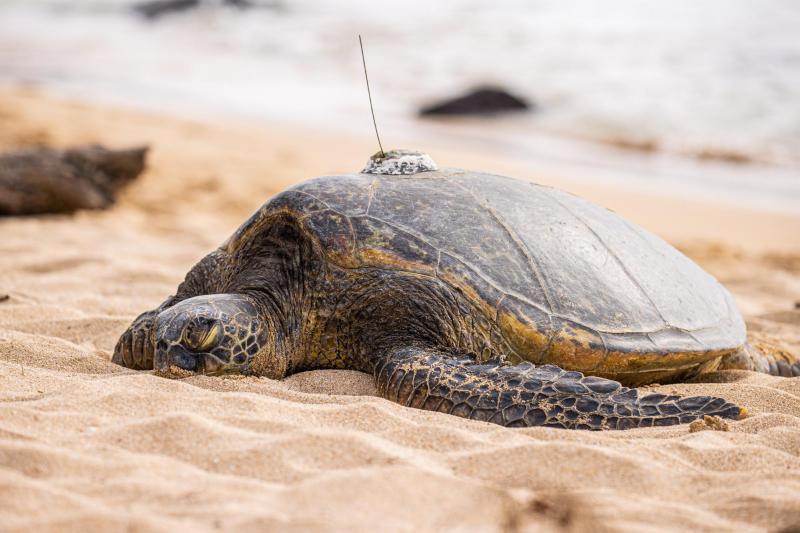Punahele, a Hawaiian green sea turtle, returned to the shores of Oʻahu on 18 August 2020. After spending 127 days traveling, basking, and nesting, she reached Laniakea beach. There, she was greeted by her friends from the non-profit organization Mālama na Honu. They were present on the beach the night before Punahele set off on her journey back in April, after NOAA researchers placed a satellite transmitter on her shell.
After wandering around and taking an offshore detour during her migration, Punahele arrived at French Frigate Shoals in the early morning of May 21. Her arrival at the small island atoll was expected because approximately 96 percent of all Hawaiian green sea turtles (or honu) lay their eggs at French Frigate Shoals. Punahele, or “Puni,” as she is lovingly called by Mālama na Honu volunteers, nested four times in French Frigate Shoals this year, despite concerning changes in its habitat.
Habitat Changes in the Atoll
Over the past 47 years, since our researchers began monitoring the turtle activity at French Frigate Shoals, these islands have been slowly eroding. Some have completely disappeared. East Island was the main nesting site, with more than 50 percent of all nesting activity in the Papahānaumokuākea Marine National Monument. However, it washed away when Hurricane Walaka hit in October 2018. The loss of the main honu nesting location could be a devastating blow to a sea turtle population already threatened with extinction.
Researchers are monitoring how the turtles respond. Will they still try to use the sandy remnants of East Island, even though its highest point barely reaches above the high tide line? Will they adapt and use some of the more stable surrounding islets? Or will they go somewhere completely different to nest?
Punahele and last year's satellite tagged turtle “Motherload” gave a glimpse of what we might expect in the next few years. We know that some turtles nest on multiple islands within French Frigate Shoals, sometimes even within the same season. With East Island getting smaller, it is very likely that honu will turn to Tern Island’s beaches in the years to come.
Tern is one of the more stable islets with nesting habitat in French Frigate Shoals. But if honu turn to Tern, researchers raise a whole new set of questions about the differences between the nesting locations that could impact the honu population:
- What is the carrying capacity of Tern Island? That is, how many nests can it support?
- What is the nest success rate on Tern Island compared to East Island?
- Will the nest temperatures be different due to different substrate type and depth? This is important because temperature affects hatching success and male-to-female sex ratios.
The answers to all of these questions are already being explored by our scientists. They have ramped up their research and survey effort on Tern Island since 2017.
Punahele’s Nesting Migration
The satellite tag data shows that Punahele visited Tern Island for several nights before laying her eggs. Turtles may try digging egg chambers in multiple spots over multiple nights to find the best suitable habitat to incubate their eggs. They start by “body pitting,” using their front flippers and body to create a pit. Then, they use their hind flippers to dig an egg chamber. Digging one nest can take hours. If they decide that the spot is unsuitable due to rocks, roots, shells, or compact substrate, they will move to a new spot and start all over.
Punahele nested on a very regular schedule: she laid all of her nests in about 2-week intervals. Between these energetic events, she hauled out on Trig, the closest neighboring islet, to rest and bask in the sun. Trig Island also went awash in 2018, and has been a very dynamic sand spit ever since, coming and going with tides, storms, and seasons.
After 71 days in French Frigate Shoals, Punahele exited the atoll in the late afternoon of July 31 and started swimming east. She arrived back home on her regular basking beach on August 18 after travelling 2,800 miles round-trip since her departure in April.
What Does this Mean for Honu?
Turtles in Hawaiʻi nest about every 4 years. During the time between nesting events, most turtles forage around the main Hawaiian Islands. In general, turtles have a small home range and like to stick to one particular foraging area at their preferred island. They do this to regain the nutrients and body condition needed to make the migration to their far-away reproduction sites again.
It will be interesting to see when and where Punahele will lay her next clutch of eggs. Will she return to Tern Island in a few years, or will she have learned that the French Frigate Shoals nesting habitat has declined and adapt to nest at another unknown destination? Our researchers will continue to investigate.




